|
|
|
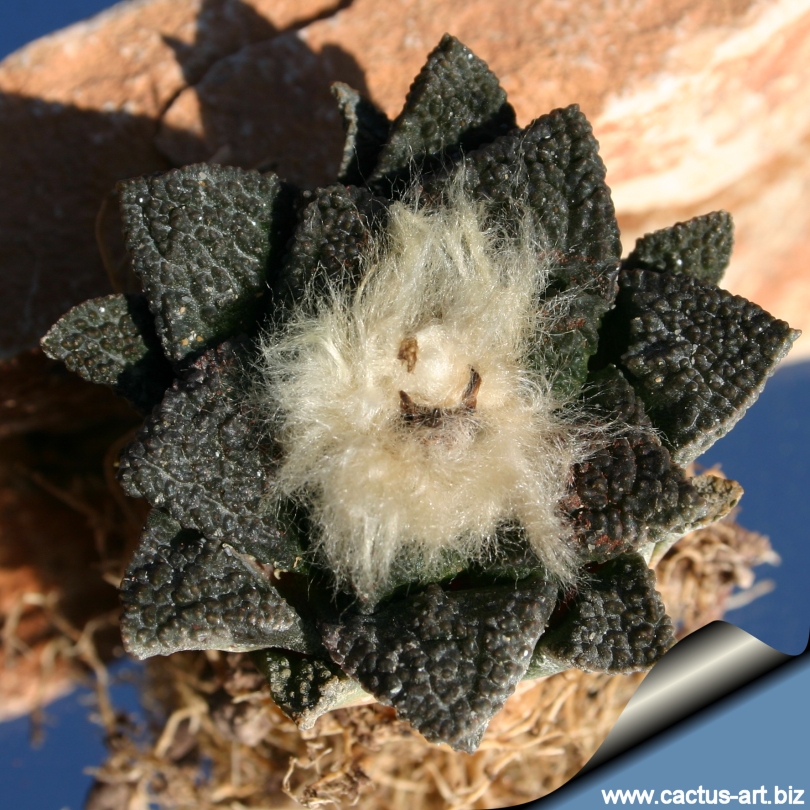
Ariocarpus intermedius KMR 5.2 El
Hundido, Coahuila, Mexico
This is is a
species of extremely slow growing cacti commonly called "living rocks,"
in habitat these cacti usually blend in well with the terrain around
them.
|
|
Description: Ariocarpus
fissuratus is a variable
geophyte species, the most interesting variant being
the A. lloydii. However the range of
these two forms merge, giving
rise to some populations with transitional characteristics known as
A. intermedius. But nowadays many botanist considered both
A. lloydii
and A. intermedius no more than varieties of
A.
fissuratus. It is usually
solitary, rarely giving rise to side
shoots from old areoles, it grows extremely slowly,
to 20 cm in diameter.
Stem: Star-shaped composed by a
rosette of fleshy,
deltoid to hemispheric
tubercles, which have no
spines. The tubercles, about as long as
wide, are coarsely
rugose, and often sharply angled apically and closely packed
to form a coarse mosaic.
Areoles: The
areoles are up to 3 mm wide, sometimes
confined to middle of tubercle faces instead of extending to tips.
Roots:
Each plant has a large
turnip-like taproot, which lies below the soil surface and serves
for
water storage.
Flowers: These plants have a
woolly
crown, from which emerge bright pink-violet
flowers up to 2.5-5 cm, 2 times wider than long when fully expanded.
Flowers last for 3 to 4 days.
Blooming season: October, November.
|
|
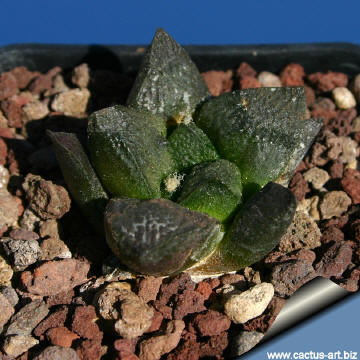
Ariocarpus intermedius SB503 |
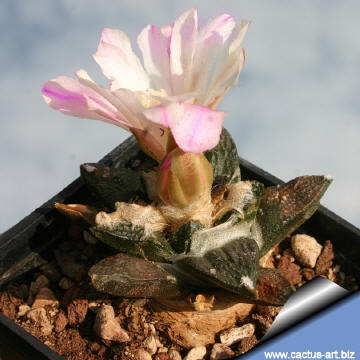
State Capital, Coahuila, Mexico |
|
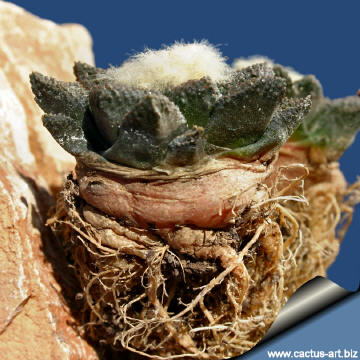 |
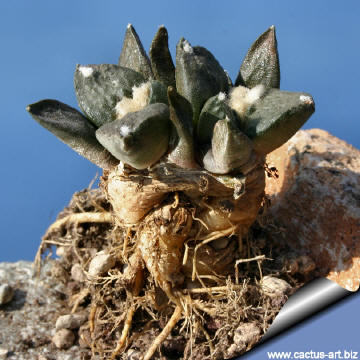 |
|
Each plant has a large
turnip-like taproot, which lies below the soil surface and serves
for
water storage. |
|


Advertising
|
|
|
|
|
|
Family:
Cactaceae (Cactus
Family)
Scientific name: Ariocarpus intermedius (Backb. & Kilian)
Voldan
Basionym: Roseocactus intermedius Backbg. and
Kilian,
In: Kakt. Sukk. 11(1 0):149 (1960)].
Conservation status: Listed in
CITES appendix I.
Synonyms:
- Ariocarpus fissuratus (Engelmann)
Schumann
in Engler and Prantl, Nat. Pflanzenfam. 3, 6a:15, 9
(1891).
- Ariocarpus fissuratus var. intermedius
- Ariocarpus fissuratus subsp. fissuratus
var. intermedius
- Ariocarpus fissuratus var. lloydii
(Rose) W. T. Marshall, 1941
|
|
|
|
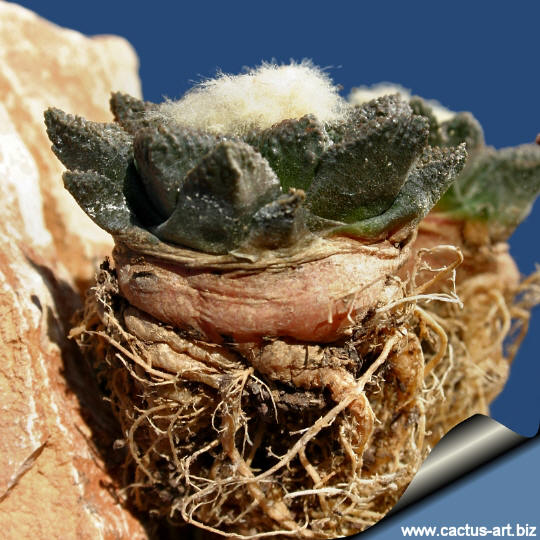
These cacti consist of many small tubercles growing from a large tap
root. They are usually solitary, rarely giving rise to side shoots from
old areoles.
Habitat and
Ecology: These plants are characteristic of dry
limestone ridges and low, rocky hills of limestone chips at an
altitude of 500-1500 m among the Chihuahuan desert
scrub.
The
stems are normally flush and well
camouflaged with the soil surface resembling limestone chips in
shape, colour, and texture, rendering the plants extremely
cryptic. They are greyish-green in colour, sometimes taking on a
yellowish tint with age. These
cacti are difficult to spot in their natural habitat. When they are
found, it is usually due to their pinkish flowers
In times of severe
drought, the whole
above-ground portion of these plants can
shrink and be covered by rock fragments, but the
taproot remains
alive. Many exist as only small, isolated
populations, and are in danger of
extinction because they sought by plant
collectors. For this reason they are
protected plants in the regions where they occur.
Cultivation is not too difficult in a
greenhouse, although A. fissuratus grows extremely slowly. The
plants need deep
pots to accommodate the
napiform unit formed by the
stem base and the
rootstock (or they will often simply crack
your pots), , and a loose
mineral soil with a well-drained
substrate. They need a good amount of
light, a place near the roof of the greenhouse helps drying the pot
after
watering. This can be done weekly during the
summertime, if the weather is sunny enough, with a little
fertilizer added. Kept this way, plants will
show a
healthy, although slow
growth. They are
frost hardy to -10°C
Propagation: By
seeds, remembering that
seedlings dislike strong
light and
dry conditions, and need to be
repotted frequently. Eventually, as they become mature, they
reach a maximum size of 25 to 27 cm. However, old
plants become
senile and have a tendency to succumb to
disease and a weak
root system. At this
stage, as is well known, they
die suddenly. So, after they reach 20 cm in diameter grow them
slowly, and adopt a new repotting period, using intervals of every 2 - 3
years. Additionally grow them under drier conditions or with stronger
sunlight. Plants are often
grafted to accelerate growth, as they would
generally take at least a decade to reach
maturity on their own. But
the grafted plants are typically rather tall-
growing, compared with plants on their own roots,
that are usually flatter to the
ground. A. fissuratus starts blooming at the
age of 8-12 years.
Photo of conspecific taxa,
varieties, forms and cultivars of plants
belonging to the Ariocarpus fissuratus/bravoanus
complex
(This
Taxon has lots of synonyms whit
several controversial varieties and subspecies):
|
|